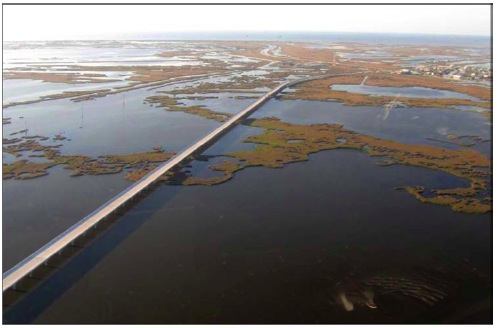UNITED STATES GOVERNMENT ACCOUNTABILITY OFFICE
Why GAO Did This Study
 According to the United States Global Change Research Program, the costs and impacts of weather disasters resulting from floods, drought, and other events are expected to increase in significance as previously “rare” events become more common and intense. These impacts pose financial risks to the federal government. While it is not possible to link any individual weather event to climate change, these events provide insight into the potential climate-related vulnerabilities the United States faces.
According to the United States Global Change Research Program, the costs and impacts of weather disasters resulting from floods, drought, and other events are expected to increase in significance as previously “rare” events become more common and intense. These impacts pose financial risks to the federal government. While it is not possible to link any individual weather event to climate change, these events provide insight into the potential climate-related vulnerabilities the United States faces.
GAO focuses particular attention on government operations it identifies as posing a “high risk” to the American taxpayer and, in February 2013, added to its High Risk List the area Limiting the Federal Government’s Fiscal Exposure by Better Managing Climate Change Risks. GAO’s past work identified a variety of fiscal exposures—responsibilities, programs, and activities that may either legally commit the federal government to future spending or create the expectation for future spending in response to extreme weather events.
This testimony is based on reports GAO issued from March 2007 to November 2013 that address these issues.
GAO is not making new recommendations but made numerous recommendations in prior reports on these topics, which are in varying states of implementation by the Executive Office of the President and relevant federal agencies.
What GAO Found
The federal government has opportunities to limit its exposure and increase the nation’s resilience to extreme weather events. Since 1980, the U.S. has experienced 151 weather disasters with damages exceeding 1 billion dollars each. This testimony focuses on 4 areas where the government could limit its fiscal exposure.
- Property and crop insurance. The financial risks from two federal insurance programs—the National Flood Insurance Program administered by the Federal Emergency Management Agency (FEMA) and the Federal Crop Insurance Corporation (FCIC)—create a significant fiscal exposure. In 2012, the NFIP had property coverage of over $1.2 trillion and the FCIC had crop coverage of almost $120 billion. As of December 2013, FEMA’s debt from flood insurance payments totaled about $24 billion. For various reasons, FCIC’s costs more than doubled from $3.4 billion in fiscal year 2001 to $7.6 billion in fiscal year 2012. In 2007, GAO found that the agencies responsible for these programs needed to develop information on their long-term exposure to climate change. The Biggert-Waters Flood Insurance Reform Act of 2012 requires FEMA to use information on future changes in sea levels and other factors in updating flood maps used to set insurance rates. Private insurers are also studying how to include climate change in rate setting. GAO is currently examining the extent to which private and federal insurance programs address risks from climate change.
- Disaster aid. The federal government does not fully budget for recovery activities after major disasters, thus creating a large fiscal exposure. GAO reported in 2012 that disaster declarations have increased to a record 98 in fiscal year 2011 compared with 65 in 2004. Over that period, FEMA obligated over $80 billion for disaster aid. GAO’s past work recommended that FEMA address the federal fiscal exposure from disaster assistance.
- Owner and operator of infrastructure. The federal government owns and operates hundreds of thousands of facilities that a changing climate could affect. For example, in its 2010 Quadrennial Defense Review, the Department of Defense (DOD) recognized the risk to its facilities posed by climate change, noting that the department must assess the potential impacts and adapt. GAO plans to report later this year on DOD’s management of climate change risks at over 500,000 defense facilities.
- Provider of technical assistance to state and local governments. The federal government invests billions of dollars annually in infrastructure projects that state and local governments prioritize, such as roads and bridges. Total public spending on transportation and water infrastructure exceeds $300 billion annually, with about 25 percent coming from the federal government and the rest from state and local governments. GAO’s April 2013 report on infrastructure adaptation concluded that the federal government could help state and local efforts to increase their resilience by (1) improving access to and use of available climate-related information, (2) providing officials with improved access to local assistance, and (3) helping officials consider climate change in their planning processes.
Download full version (PDF): Extreme Weather Events
About the United States Government Accountability Office
www.gao.gov
“The U.S. Government Accountability Office (GAO) is an independent, nonpartisan agency that works for Congress. Often called the “congressional watchdog,” GAO investigates how the federal government spends taxpayer dollars.”
Tags: GAO, Resilience, United States Government Accountability Office






 RSS Feed
RSS Feed